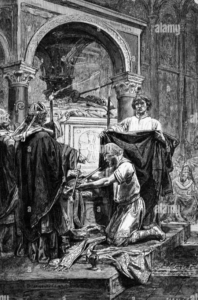– For the context of these translations click here –
The conscienceless episcopal mob once again changed sides
After Louis’s deposition in 833, long years of bitter struggles ensued not only between father and son but also between the brothers, with frequent changes of sides. The desire to dominate various portions of sovereignty led to shifting coalitions according to the expected advantages. This was the strongest political principle, the punctum saliens par excellence. In the beginning, it is clear that the three brothers were looking for ways to increase their power: Pippin of Aquitaine and Louis the Germanic against Lothair, and Lothair against both of them.
In the meantime, in November 834, at the imperial diet of Attigny, the general bad situation had again been mentioned, and again a promise had been made to remedy it. But all that happened was Louis the Pious’ command to return as soon as possible the ecclesiastical goods alienated in Aquitaine. The misery of the people remained unchanged.
At an imperial assembly convened on 2 February 835 in the palace of Diedenhofen, which was above all an ecclesiastical assembly, Louis demanded that the declaration of the nullity of his deposition and canonical penitence, which had already been made at Saint-Denis, be repeated explicitly and more solemnly. And, naturally, the venerable prelates now agreed. ‘A great assembly of almost all the bishops and abbots of the whole empire’ naturally declared ‘unworthy’ the resolution of Compiègne—which was theirs—and declared the machinations of the imperial enemies and the ‘disloyalty of the wicked and enemies of God’ to be annulled by a new ‘sentence of God’.
Thus, just one year after Louis’ release, those always repugnant opportunists again proceeded most solemnly to the reinstatement of the sovereign within the imperial assembly held in the cathedral of Metz on 28 February 835. It is true that Louis’ confidence in the ecclesiastical leaders may have been somewhat shaken. In any case, he remained deaf to their complaints and entreaties, apart from the fact that he had to return the stolen ecclesiastical property.
Louis the Pious, whose lungs had become obstructed, whose chest had weakened and who had aged prematurely, and who was also afflicted by an incurable ulcer, perhaps pulmonary emphysema, began to languish with frequent chest tightness, nausea and a total refusal of food. After passing through the royal palace of Salz in the Frankish Saale and after having arrived by boat on the Main to Frankfurt, Louis I died on Sunday, 20 June 840, in a ‘tent-like summer dwelling’ on a small island in the Rhine downstream from Mainz. The island was opposite Ingelheim and was the sumptuous Carolingian palace where his father had once subjected the Bavarian Duke Tassilo and his family to a notorious trial; later Charles IV converted it into a monastery and it was finally demolished during the Peasants’ War and the Thirty Years’ War.
Louis had been King of Aquitaine for 37 years and Emperor for 27. Those closest to him, his wife Judith and his son Charles were far from him in Aquitaine. Instead, several prelates, including his former jailer Otgar of Mainz, surrounded his deathbed. As long as he could, the emperor made the sign of the cross on his forehead and chest. He also had a splinter of the (claimed) cross of Christ placed on his chest.
Burial in Saint Arbnulf Abbey in Metz.
The body of Louis the Pious was taken to Metz, and there, in the old family pantheon of the Carolingians, he was laid to rest ‘with all honour’ next to his mother Hildegard—although all the children were absent—by his half-brother Drogo. At the time of the French Revolution, the body was removed from the sarcophagus.
